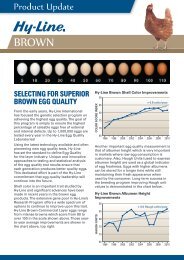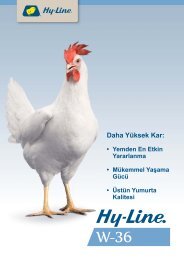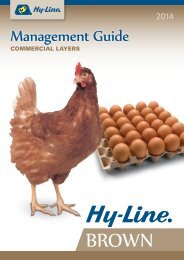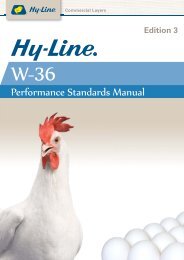Hy-Line Sonia Commercial Performance Standards Manual
Hy-Line Sonia Commercial Performance Standards Manual
Hy-Line Sonia Commercial Performance Standards Manual
- No tags were found...
Create successful ePaper yourself
Turn your PDF publications into a flip-book with our unique Google optimized e-Paper software.
<strong>Commercial</strong> LayersEdition 1SONIA<strong>Performance</strong> <strong>Standards</strong> <strong>Manual</strong>
<strong>Hy</strong>-<strong>Line</strong> International<strong>Hy</strong>-<strong>Line</strong> <strong>Sonia</strong> <strong>Commercial</strong> LayersGrowing/Laying RecommendationsWater Consumption for Pullets andLayersDrinking WaterWater is the most important nutrient and good-quality watermust be available to the birds at all times. Only in special cases(e.g., prior to vaccine delivery through the drinking water),should drinking water be restricted, and then only for a shorttime and under careful monitoring.Monitoring Drinking Water IntakeWater and feed consumption are directly related—when birdsdrink less water, they consume less feed, and productionquickly declines accordingly. As a general rule, healthy adultbirds will consume twice as much water as feed, although theratio increases during periods of warm weather. Installation anduse of water meters in each house or barn are recommendedto monitor the flock’s water intake on a daily basis. Such dailywater-intake records can be used as an early warning ofproblems in the flock.Water Consumed per 100 Birds per DayChicks should consume 0.83 liters per 100 birdson day one of age.Age in WeeksLiters1 0.8–1.12 1.1–1.93 1.7–2.74 2.5–3.85 3.4–4.76 4.5–5.77 5.7–6.88 6.1–8.09 6.4–9.510–15 6.8–10.216–20 7.2–15.221–25* 9.9–18.2Over 25* 15.2–20.8* Chart shows an expected range of water consumption at normalenvironmental temperatures for bird comfort (21–27°C). At highertemperatures (32–38°C) water consumption may increase up todouble the amounts shown.Lighting ProgramsEgg production is very closely related to the changes in daylength. Body weight gain in grow, egg numbers, egg size,livability, and total profi tability can be favorably infl uenced by aproper lighting program.When open-type houses are used, which allow natural daylightto affect the fl ock, the lighting program must be planned inconjunction with changes in the natural day length. Becauseno two places have the same sunrise-sunset times yearround,custom lighting programs for any location worldwide areavailable.A customizable lighting program is available in multiplelanguages and will create a downloadable spreadsheet withsunrise and sunset times for any location in the world and thelighting program for your fl ock. Visit www.hyline.com to accessthe customizable lighting program.Controlling Egg WeightIt is recommended to closely monitor feed intake, bodycondition (through body weight and/or body scoring/fatpaddevelopment), and egg weight of each flock and makenutritional changes as needed to ensure optimal productionrate and egg weight. If smaller eggs are desired, the egg weightshould be controlled even more aggressively at an early age.Egg-weight control is achieved through a combination oflimiting amino acid consumption and ensuring that the feedintake is not too high (achieved through control of the ambienttemperature). To avoid excessively large eggs later in lay, usethe peaking and second layer feeding phase diets for less timethan shown in the <strong>Performance</strong> <strong>Standards</strong> <strong>Manual</strong>. This willprovide a reduced level of added fat or oil, as well as aminoacid contents, to control egg weight.Control of ambient house temperatureAt housing, an ambient temperature of 21 to 23˚C is desired.Increase the house temperature about 1˚C every 2 weeks untilreaching a house temperature of 26 to 27˚C (assuming theventilation systems are able to maintain adequate air quality atthese temperatures). Lower (colder) house temperatures willlead to greater feed intakes and may be counterproductive toegg-weight control, as well as optimal feed efficiency and adulthen body weights.Colony/Cage Space Recommendations in Laying HouseU.S. Recommendations(United Egg Producers)E.U. RecommendationsEnriched Colony Systems*Bird Space 432–555 cm 2 /bird 750 cm 2 /bird (600 usable cm 2 )Feeder 7.6 cm/bird 12 cm/birdCups or nipples drinking system 1 per 12 birds 2 within reach of each birdPerches — 15 cm/bird* See regulations for other requirements such as nests, litter area, clearance, etc. Some countries have more specific requirements.© 2012 <strong>Hy</strong>-<strong>Line</strong> International3
<strong>Hy</strong>-<strong>Line</strong> International<strong>Hy</strong>-<strong>Line</strong> <strong>Sonia</strong> <strong>Commercial</strong> LayersTarget Weights—Growing Period—Age inBody Weight*Weeks g1 702 1153 1904 2805 3806 4907 5908 7109 81010 92011 102012 112013 119014 126015 133016 140017** 146018 1500* Pullets grown on the floor or in a tropical climate can be 50 g lighterthan shown.** Move to Lay houseFeed Consumption*—Growing Period—Age in Daily CumulativeWeeks g/day per bird g to date1 13 912 20 2313 25 4064 29 6095 33 8406 37 10997 41 13868 46 17089 51 206510 56 245711 61 288412 66 334613 70 383614 73 434715 75 487216 77 541117 78 5957* Pullet feed consumption varies with feed formulation andenvironmental temperatures.Added Vitamins and Trace Minerals—Growing Period——Laying Period—Item 1 In 1000 kg complete diet In 1000 kg complete dietVitamin A, IU 9,900,000 8,800,000Vitamin D 3, IU 3,300,000 3,300,00025-hydroxy Vitamin D 3, 2 mg 55 55Vitamin E, IU 22,100 16,500Vitamin K (menadione), g 3.3 2.2Thiamin (B 1), g 2.2 1.7Riboflavin (B 2), g 6.6 5.5Niacin (B 3), g 33 28Pantothenic acid (B 5), g 11.0 6.6Pyridoxine (B 6), g 4.4 3.3Biotin (B 7), mg 55 55Folic acid (B 9), g 0.9 0.6Cobalamine (B 12), mg 22.1 22.1Choline, g 110 110Manganese 3 , g 88 88Zinc 3 , g 88 88Iron, g 55 55Copper, g 11.0 5.5Iodine, g 1.7 1.7Selenium, g 0.30 0.301Minimum recommendations for growing and laying periods. Local regulations may limit the dietary content of individual vitamins or minerals.2If 25-OH Vitamin D 3is added to the diet, the levels of ‘regular’ Vitamin D 3in the premix could be lowered in accordance with the manufacturer’srecommendations or to comply with local laws regulating the total amount of Vitamin D 3added to the diet.320% of Manganese or Zinc may be in organic form.© 2012 <strong>Hy</strong>-<strong>Line</strong> International4
<strong>Hy</strong>-<strong>Line</strong> International<strong>Hy</strong>-<strong>Line</strong> <strong>Sonia</strong> <strong>Commercial</strong> LayersGrowing Period Nutrition RecommendationsItem 1 Starter 1 Starter 2 Grower Developer Pre-Lay 5Feed to a body weight of 190 g 490 g 1120 g 1330 g 1460 gApproximate age 0–3 weeks 4–6 weeks 7–12 weeks 13–15 weeks 16–17 weeksRecommended concentration 2Metabolizable energy, kcal/kg 2756–2999 2756–2999 2734–2999 2734–2999 2734–2999Metabolizable energy, MJ/kg 11.54–12.55 11.54–12.55 11.44–12.55 11.44–12.55 11.44–12.55Minimum recommended concentrationStandardized (true) ileal digestible amino acidsLysine, % 1.00 0.91 0.82 0.69 0.73Methionine, % 0.45 0.41 0.38 0.32 0.34Methionine+cystine, % 0.73 0.68 0.64 0.57 0.60Threonine, % 0.66 0.61 0.56 0.48 0.51Tryptophan, % 0.17 0.16 0.16 0.14 0.15Arginine, % 1.07 0.97 0.88 0.74 0.78Isoleucine, % 0.70 0.66 0.61 0.52 0.58Valine, % 0.72 0.67 0.64 0.55 0.62Total amino acids 3Lysine, % 1.09 1.00 0.90 0.76 0.80Methionine, % 0.48 0.44 0.41 0.35 0.37Methionine+cystine, % 0.82 0.77 0.72 0.65 0.68Threonine, % 0.78 0.72 0.66 0.56 0.60Tryptophan, % 0.20 0.20 0.19 0.16 0.18Arginine, % 1.15 1.05 0.94 0.79 0.84Isoleucine, % 0.75 0.70 0.65 0.56 0.63Valine, % 0.79 0.74 0.71 0.61 0.68Crude protein (nitrogen × 6.25), 3 % 20.00 19.00 17.50 15.50 16.00Calcium, 4 % 1.00 1.00 1.00 1.40 2.50Phosphorus (available), % 0.48 0.49 0.45 0.41 0.45Sodium, % 0.18 0.18 0.18 0.18 0.18Chloride, % 0.18 0.18 0.18 0.18 0.18Linoleic acid (C18:2 n-6), % 1.00 1.00 1.00 1.00 1.001Change diets at the recommended target body weight—the approximate age is a guide only.2Differences in the metabolizable energy value assigned to feed ingredients of the same name can differ substantially; in some cases, the recommendeddietary energy content may have to be adjusted accordingly (see the <strong>Hy</strong>-<strong>Line</strong> Red Book, an Online Management Guide for additional information).3The minimum recommendations for total amino acids and crude protein are only appropriate with a corn and soybean meal diet; please formulate the dieton digestible amino acid basis instead.4Calcium should be supplied as a fine calcium carbonate source (mean particle size less than 2 mm).5Feed the Pre-Lay Diet for one or two weeks before the onset of egg production, when most pullets show some enlargement and reddening of their combs.Be prepared to change to the Peaking Diet at no later than 0.5–1.0% daily egg production, as the Pre-Lay Diet does not contain sufficient calcium to sustainegg production.© 2012 <strong>Hy</strong>-<strong>Line</strong> International5
<strong>Hy</strong>-<strong>Line</strong> International<strong>Hy</strong>-<strong>Line</strong> <strong>Sonia</strong> <strong>Commercial</strong> Layers<strong>Performance</strong> TableAge in % Hen-Day % MortalityHen-DayEggsHen-HousedEggs Body WeightAverageEgg Weight*FeedConsumptionEgg MassCumulativeEgg QualityWeeks Cumulative Cumulative Cumulative kg g/egg g/day per bird kg HaughUnitsBreakingStrengthShellColor61 81 2.5 253.3 250.3 1.91 65.0 110 15.7 85.4 4090 4262 81 2.6 258.9 255.7 1.91 65.0 110 16.0 85.2 4080 4263 80 2.7 264.5 261.2 1.91 65.0 110 16.4 84.9 4070 4164 79 2.7 270.1 266.6 1.91 65.0 110 16.8 84.7 4060 4165 79 2.8 275.6 272.0 1.91 65.0 110 17.1 84.4 4050 4166 78 2.9 281.1 277.3 1.91 66.0 110 17.5 84.1 4040 4167 78 3.0 286.5 282.5 1.92 66.0 110 17.8 83.8 4030 4168 77 3.1 291.9 287.8 1.92 66.0 110 18.2 83.5 4020 4069 76 3.2 297.2 292.9 1.92 66.0 110 18.5 83.3 4010 4070 76 3.3 302.6 298.1 1.92 66.0 110 18.9 83.0 4000 4071 75 3.4 307.8 303.2 1.92 66.0 110 19.2 82.8 3990 4072 75 3.5 313.0 308.2 1.92 66.0 110 19.6 82.6 3980 4073 74 3.6 318.2 313.2 1.92 67.0 110 19.9 82.4 3970 4074 73 3.8 323.4 318.1 1.92 67.0 110 20.3 82.1 3960 3975 73 3.9 328.5 323.0 1.92 67.0 110 20.6 81.9 3950 3976 72 4.0 333.5 327.9 1.92 67.0 110 21.0 81.7 3940 3977 72 4.1 338.5 332.7 1.92 67.0 110 21.3 81.4 3930 3978 71 4.2 343.5 337.4 1.92 67.0 110 21.6 81.2 3920 3979 70 4.4 348.4 342.2 1.92 67.0 110 22.0 81.0 3910 3880 70 4.5 353.3 346.8 1.92 67.0 110 22.3 80.8 3900 38* Egg weights after 40 weeks of age assume phase feeding of protein to limit egg size.<strong>Hy</strong>-<strong>Line</strong> <strong>Sonia</strong> Egg Shell Color Range© 2012 <strong>Hy</strong>-<strong>Line</strong> International9
<strong>Hy</strong>-<strong>Line</strong> International<strong>Hy</strong>-<strong>Line</strong> <strong>Sonia</strong> <strong>Commercial</strong> Layers<strong>Performance</strong> GraphPercent or gramsKilograms100959085807570656055504540353025201510503.02.82.62.42.22.01.81.61.41.21.0Hen-Day Egg Production (%)Egg Weight (g)Body Weight (kg)Mortality (%)16 20 24 28 32 36 40 44 48 52 56 60 64 68 72 76 80Age (weeks)© 2012 <strong>Hy</strong>-<strong>Line</strong> International10
<strong>Hy</strong>-<strong>Line</strong> International<strong>Hy</strong>-<strong>Line</strong> <strong>Sonia</strong> <strong>Commercial</strong> LayersAge inWeeksAverageEgg Weight (g)Egg Size Distribution—E.U. <strong>Standards</strong>% Very LargeOver 73 g% Large63–73 g% Medium53–63 g% Small43–53 g22 51.0 0.00 0.62 33.23 61.3724 55.0 0.02 5.82 59.42 33.8226 57.0 0.13 12.75 64.60 22.1128 59.0 0.41 22.11 64.60 12.7530 60.0 0.62 27.58 62.89 8.8632 61.0 0.82 33.64 60.06 5.4634 62.0 1.24 40.68 54.77 3.3136 62.0 1.24 40.68 54.77 3.3138 63.0 1.86 48.14 48.14 1.8640 63.0 1.86 48.14 48.14 1.8642 64.0 3.04 50.21 45.01 1.7444 64.0 3.31 54.12 41.14 1.4346 64.0 3.31 54.12 41.14 1.4348 64.0 3.59 54.33 40.68 1.3950 64.0 3.59 54.33 40.68 1.3952 65.0 5.84 57.42 35.62 1.1254 65.0 5.84 57.42 35.62 1.1256 65.0 6.20 57.78 34.97 1.0558 65.0 6.20 57.78 34.97 1.0560 65.0 6.56 57.78 34.61 1.0562 65.0 6.56 57.78 34.61 1.0564 65.0 6.56 57.78 34.61 1.0566 66.0 9.74 60.90 28.56 0.8068 66.0 9.74 60.90 28.56 0.8070 66.0 10.16 60.48 28.56 0.8072 66.3 11.16 61.42 26.65 0.7874 66.6 12.23 61.42 25.64 0.7176 66.8 13.41 61.31 24.59 0.6978 67.1 14.60 61.24 23.49 0.6780 67.3 15.87 61.20 22.31 0.63© 2012 <strong>Hy</strong>-<strong>Line</strong> International11
<strong>Hy</strong>-<strong>Line</strong> International<strong>Hy</strong>-<strong>Line</strong> <strong>Sonia</strong> <strong>Commercial</strong> LayersAge inWeeksAverageEgg Weight(g)Egg Size Distribution—Japanese <strong>Standards</strong>% Over76 g% LL70–76 g% L64–70 g% M58–64 g% MS52–58 g% S46–52 g% SS40–46 g% Under40 g20 46.0 0.00 0.00 0.00 0.45 9.15 40.39 40.39 9.6122 51.0 0.00 0.00 0.33 6.90 34.51 43.37 13.78 1.1024 55.0 0.00 0.16 3.72 23.94 44.36 23.94 3.72 0.1626 57.0 0.02 0.69 8.62 33.19 40.21 15.38 1.83 0.0728 59.0 0.07 1.83 15.38 40.21 33.19 8.62 0.69 0.0230 60.0 0.10 2.62 19.36 42.89 28.83 5.84 0.35 0.0132 61.0 0.16 3.46 23.83 45.15 23.81 3.46 0.13 0.0034 62.0 0.21 4.91 29.03 45.13 18.65 2.01 0.05 0.0036 62.0 0.21 4.91 29.03 45.13 18.65 2.01 0.05 0.0038 63.0 0.34 6.54 34.51 43.37 14.15 1.08 0.02 0.0040 63.0 0.34 6.90 34.51 43.37 13.78 1.08 0.02 0.0042 64.0 0.62 9.94 38.96 39.44 10.22 0.80 0.02 0.0044 64.0 0.72 10.32 38.96 38.96 10.22 0.80 0.02 0.0046 64.0 0.72 10.32 38.96 38.96 10.22 0.80 0.02 0.0048 64.0 0.82 10.69 38.96 38.49 10.22 0.80 0.02 0.0050 64.0 0.82 10.69 38.96 38.49 10.22 0.80 0.02 0.0052 65.0 1.55 14.79 41.43 33.73 7.95 0.53 0.01 0.0054 65.0 1.55 14.79 41.43 33.73 7.95 0.53 0.01 0.0056 65.0 1.72 15.09 40.81 33.54 8.29 0.53 0.01 0.0058 65.0 1.72 15.09 40.81 33.54 8.29 0.53 0.01 0.0060 65.0 1.90 15.38 40.21 33.25 8.72 0.53 0.01 0.0062 65.0 1.90 15.38 40.21 33.25 8.72 0.53 0.01 0.0064 65.0 1.90 15.38 40.21 33.25 8.72 0.53 0.01 0.0066 66.0 3.20 19.74 41.50 28.63 6.45 0.47 0.01 0.0068 66.0 3.20 19.74 41.50 28.63 6.45 0.47 0.01 0.0070 66.0 3.45 19.90 41.20 28.52 6.45 0.47 0.01 0.0072 66.3 3.89 21.17 41.06 27.23 6.18 0.45 0.01 0.0074 66.6 4.37 22.45 41.06 25.93 5.78 0.40 0.01 0.0076 66.8 5.02 23.36 40.73 25.05 5.42 0.40 0.01 0.0078 67.1 5.60 24.63 40.73 23.79 4.90 0.34 0.01 0.0080 67.3 6.35 25.44 40.16 22.99 4.73 0.32 0.01 0.00© 2012 <strong>Hy</strong>-<strong>Line</strong> International12
<strong>Hy</strong>-<strong>Line</strong> International Welfare Goals and PrinciplesTo promote animal well-being and produce birds of the highest quality, we adhereto the following welfare goals and principles. These goals and principles are theessential building blocks for the humane and professional care of our birds:• Feed and WaterProvide access to good quality water and nutritionally balanced diets at all times• Health and Veterinary CareProvide science-based health programs and prompt veterinary care• EnvironmentProvide shelter that is designed, maintained and operated to meet the bird’sneeds and to facilitate daily inspection• Husbandry and Handling PracticesProvide comprehensive care and handling procedures that ensure the bird’swell-being throughout its life• TransportationProvide transportation that minimizes travel time and stresswww.hyline.cominfo@hyline.com<strong>Hy</strong>-<strong>Line</strong> is a brand name. ® Registered Trademark of <strong>Hy</strong>-<strong>Line</strong> International.©Copyright 2012. <strong>Hy</strong>-<strong>Line</strong> International. M.COM.SO.E.10-12.ED.01.A4
















